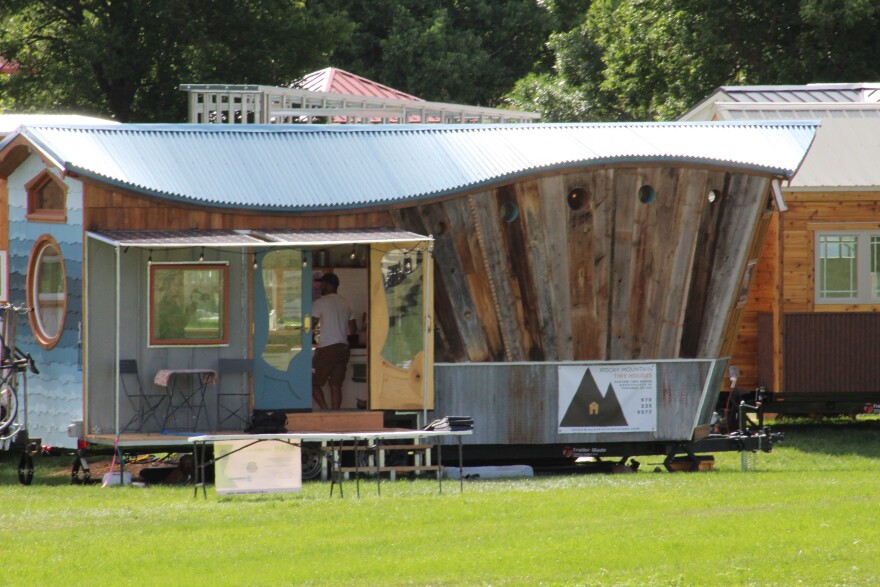Ally Shea's kitchen is very bright. The high ceilings and two-tone blue and white cabinets make it feel spacious. She said she has about 5 feet of counter space.
That's significant, as Shea, along with her husband Kevin Martin and their three-year-old twin boys, live in a so-called "tiny house."
The 272-square foot home, sitting on a goose neck trailer, is slightly bigger than an average one-car garage. The kitchen sits in the middle, flanked by one closet, a small living space and two bedrooms. One is a loft, which adds about another 70 square feet. The combined laundry and bathroom at the back of the trailer is surprisingly spacious.
"Our bathroom is huge. The boys love baths, they actually hate showers," said Shea. "So, we knew we needed a bath tub."
Shea and Martin opened their home to the public as part of the Colorado Tiny House Festival in June. The event featured dozens of unique small dwellings, from container homes and bus conversions to yurts. HGTV reality shows and DIY YouTube channels have popularized the tiny house movement. Festivals like this one, held at the Adams County Fairgrounds, happen all over the U.S., bringing together owners, builders, potential buyers and people who are just fascinated by the concept.
But these tiny structures have a big problem: where to park them.
"We kept getting kicked off properties"
Shea decided to downside for several reasons, including a desire to shed a large mortgage and have more family time. Shea says the death of her father at age 65 was the final straw; he never got to enjoy his retirement savings.
The couple sold their 1,100-square foot home in Seattle and bought their tiny home for $130,000. In January, they hit the road. The family traveled through Oregon, down the coast of California and across Arizona. During the trip, they stayed in RV parks or, since their tiny house doesn't have to be hooked up to utilities, camped in national parks like Joshua Tree.
Shea and Martin eventually ended up in Durango and parked in a friend's backyard. This is where they ran into trouble.
"We stayed (in Durango) for seven weeks, but stayed in a bunch of different places," said Shea. "We kept getting kicked off properties in Durango."
In Colorado and much of the U.S., it's illegal to park a tiny house anywhere but an RV park. Shea and Martin either had to move or receive a zoning violation ticket.
"A need for a change"
In Colorado local municipalities have their own zoning rules and regulations. They determine what building codes work best for their community.
Kristin Sullivan, director of community and economic development at Adams County, said a single-family home in unincorporated Adams County must be at least 1,200 square feet. Cities and towns in the county - like Brighton, Thornton and Bennet - also have their own unique regulations.
Sullivan said zoning rules exist to create consistency and predictability in neighborhoods.

Besides size restrictions, mobile tiny dwellings face another issue: In many places, houses are required to be on foundations and hooked up to public utilities.
Sullivan said that the regulations are a sign of the times they were created in and are slow to evolve.
"Sometimes zoning regulations are established years ago and continue on until there's a need for a change," said Sullivan.
That change could be here. The International Residential Code, or IRC, establishes the minimum requirements for one and two-family dwellings and townhouses. It's in use or has been adapted for use by 49 states, the District of Columbia, Guam, Puerto Rice and the U.S. Virgin Islands.
In 2018, the IRC added Appendix Q. It gives tiny houses - homes 400 square feet or less - industry-wide building standards.

"The domino fell"
Michael Buccino lives in Steamboat Springs and is on the city's planning committee. He is an interior designer and founder of Micro Living LLC, which plans to build a tiny home community in unincorporated Routt County.
When Routt County adopted the 2018 IRC, a path to building permanent dwellings was cleared.
"2018. All of a sudden, the domino fell," said Buccino. "That domino said, 'Hey, if you want to start building? Build a tiny home, build it anywhere you want. Follow the code.' The building department now becomes part of the process."

Buccino plans to buy a parcel of land for two single-family homes in the county and build six tiny houses. They would be on foundations and connected to sewer, water and electricity.
But he said it's been hard to get a bank loan to finance the project.
"There's nothing to compare it to," he said. "How much is a tiny home on a tiny piece of land on a group of six homes worth? No one knows."
The community is still in the planning stages, but Micro Living LLC is taking pre-sale reservations.
"Coop communities"
Unfortunately, for mobile tiny home dwellers who want to live "off-the-grid," use green energy or composting toilets, a permanent location is still a dream.
But Ally Shea and Kevin Martin are committed to tiny living and participated in the Colorado Tiny House Festival to raise awareness about the movement.
Martin works in digital media marketing and hopes to start working remotely soon. In a couple years, Shea, a former teacher, will homeschool the boys. By the time the kids turn five, they hope to have a plot of land next to other tiny home dwellers.
"Hopefully they'll be communities popping up," said Shea. "Coop communities is what a lot of us are envisioning."










